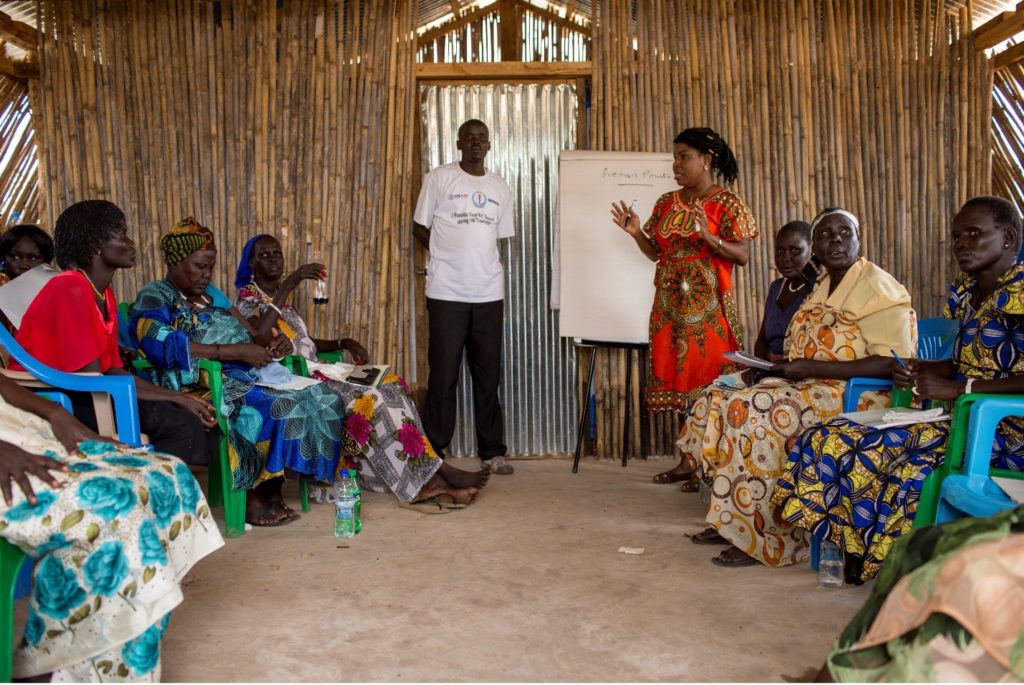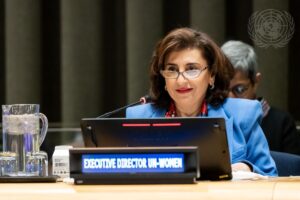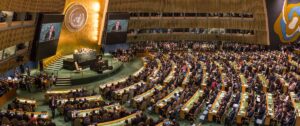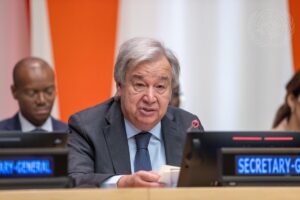Recommendation:
Give the UN’s recently consolidated Department of Political and Peacebuilding Affairs a central role in coordinating and compiling UN knowledge and analysis in conflict prevention, with special attention to averting mass atrocities, focusing on the Responsibility to Prevent principle.
Global Challenge Update:
Since 2014, conflict and fragility have been on the rise. Fifty-two active state-based armed conflicts were recorded in 2018—the highest number since 1991—driven by eighteen “internationalized intrastate” conflicts, those with “troops from external states supporting one or both sides in the conflict.”1Pettersson, Therése, Stina Högbladh and Magnus Öberg. “Organized violence, 1989-2018 and peace agreements.” Journal of Peace Research, 2019, Vol. 56, no. 4 (2019): 590. Accessed May 28, 2020. https://journals.sagepub.com/doi/pdf/10.1177/0022343319856046.
While the fast-spreading COVID-19 pandemic has ravaged big and small, rich and poor countries alike, fragile and conflict-affected countries have come under particularly acute strain. On March 23, 2020, UN Secretary-General António Guterres called for a global ceasefire in all corners of the world to better focus on “the true fight of our lives.”2United Nations Secretary-General António Guterres. “COVID-19: UN chief calls for global ceasefire to focus on ‘the true fight of our lives’.” New York: United Nations. Accessed May 10, 2020. https://news.un.org/en/story/2020/03/1059972. The Security Council failed to support the call immediately and only after three months of negotiations did it adopt a resolution (resolution 2532) demanding a cessation of hostilities worldwide.3Julian Borger. “US blocks vote on UN’s bid for global ceasefire over reference to WHO.” The Guardian, May 8, 2020. Accessed May 10, 2020. https://www.theguardian.com/world/2020/may/08/un-ceasefire-resolution-us-blocks-who. The pandemic has further burdened the lives of people in countries such as Syria, Yemen, and the Democratic Republic of the Congo, where ongoing political violence already inhibits the delivery of life-saving assistance and rises to the level of mass atrocities with numbing regularity.4See, for example, Global Centre for the Responsibility to Protect, R2P Monitor. Issue 50, March 15, 2020. Accessed May 29, 2020. https://www.globalr2p.org/publications/r2p-monitor-issue-50-15-march-2020/.
Fifteen years ago, Member States collectively endorsed the Responsibility to Protect (R2P) populations from genocide, war crimes, ethnic cleansing, and crimes against humanity, when those populations’ governments manifestly fail to do so, and committed to “assisting those which are under stress before crises and conflicts break out.”5United Nations. General Assembly. 2005 World Summit Outcome. A/RES/60/1. October 24, 2005, paras. 138, 139. Preventing violent conflict saves lives and creates space for building effective and equitable service delivery capacity and the accompanying inclusive governance culture that fragile states tend to sorely lack.6Commission on Global Security, Justice & Governance (Albright-Gambari Commission). Confronting the Crisis of Global Governance. The Hague and Washington, D.C.: The Hague Institute for Global Justice and Stimson Center, 2015, 25. The United Nations’ current toolkit for conflict prevention and response has proved effective at times, but many challenges persist. Current prevention efforts, though a high priority for UN Secretary-General António Guterres, are modest in scale relative to need and insufficient to address the complex, asymmetric nature of contemporary conflicts.7Ponzio, Richard, Joris Larik et al. An Innovation Agenda for UN75. The Albright-Gambari Commission Report and the Road to 2020. Washington DC: The Stimson Center, 2019, 24. Building the capacity of states to prevent atrocities requires far closer attention to the political, social, and institutional factors known to generate political extremism and violence. And to do that, the UN system needs greater capacity for integrated conflict preventive action, underpinned by greater institutional “situational awareness.”8Willmot, Haidi. Improving U.N. Situational Awareness. Enhancing the U.N.’s Ability to Prevent and Respond to Mass Human Suffering and to Secure the Safety and Security of Its Per-sonnel. Washington, D.C.: The Stimson Center, 2017, 13–17, 73–81. Accessed June 5, 2020. https://www.stimson.org/2017/improving-un-situational-awareness/.
Innovation Proposal:
The UN needs to better link up its widely distributed conflict analysis and crisis warning capabilities. There are UN elements to build on, such as the 2014 Framework of Analysis for Atrocity Crimes,9United Nations. Office of the Special Advisers for Genocide Prevention and the Responsibility to Protect. Framework of Analysis for Atrocity Crimes. 2014. Accessed June 2, 2020. https://www.un.org/en/genocideprevention/documents/publications-and-resources/Genocide_Framework%20of%20Analysis-English.pdf. to help assess and to avert future mass atrocity events. A responsibility center—logically located within the UN’s recently consolidated Department of Political and Peacebuilding Affairs (DPPA)—could both strengthen DPPA’s efforts at prevention and support the Office of the Special Advisers for Genocide Prevention and the Responsibility to Protect by coordinating information and analysis to enable quicker decision-making and early action. Using as a point of departure the Responsibility to Prevent dimension of R2P—as envisaged by the 2001 International Commission on Intervention and State Sovereignty—all major UN agencies and programs with the interest and ability to support conflict prevention efforts within their particular purviews should, in turn, contribute to a coordinated plan of action, led by the new responsibility center, for UN system-wide sharing of prevention-relevant data and analysis. This effort, in turn, could be used for signaling violent conflict, including atrocities and violent extremism.
The UN’s prevention toolbox should draw lessons from the Human Rights Council’s Universal Periodic Review (UPR) process to facilitate national reflection on the risks of atrocity crimes. It should build an assessment of risk factors for atrocity crimes into the basic structure of the UPRs as recommended by the Secretary-General.10United Nations. General Assembly. Security Council. Implementing the responsibility to protect: accountability for prevention. Report of the Secretary-General. A/71/1016-S/2017/556. August 10, 2017, paras. 34–37. and United Nations. General Assembly. Security Council. Responsibility to protect: lessons learned for prevention. Report of the Secretary-General. A/73/898-S/2019/463. June 10, 2019, para. 9. Regional organizations—given that many conflicts have regional implications—as well as governments, local peacebuilders, and civil society representatives should also be regularly consulted by the conflict prevention responsibility center. Similarly, UN Country Teams should be equipped to play a key role in collecting and communicating data to the headquarters.
Strategy for Reform on the Road to 2020 (UN75):
The UNSC cannot be the only organ relevant to R2P if preventing conflicts and atrocities is to be undertaken seriously. We now have fifteen years of experience and a growing body of serious work to draw upon in developing a coordinated knowledge-building initiative on the part of the UN system, in consultation with regional organizations and a growing number of non-governmental networks.11Genocide Watch. https://www.genocidewatch.com/; Institute on the Holocaust and Genocide. https://www.ihgjlm.com/directory-of-organizations-for-genocide-awareness/; Early Warning Project. Accessed May 17, 2020. https://earlywarningproject.ushmm.org/.
Fortunately, the draft UN75 Declaration lends high-level political support to the Secretary-General’s call for a global cease-fire and requests him, in turn, to enhance “the diplomatic toolbox of the Charter” so as to better “prevent the outbreak, escalation and recurrence of hostilities.”12United Nations. Declaration of the Commemoration of the Seventy-Fifth Anniversary of the United Nations. Draft, July 3, 2020, 3. Accessed July 3, 2020. https://www.un.org/pga/74/wp-content/uploads/sites/99/2020/07/UN75-FINAL-DRAFT-DECLARATION.pdf. This, along with the Secretary-General’s emphasis on prevention and sustaining peace, and the progressive shift in the UN’s operationalization of conflict prevention, could present opportune moments to steer political attention and resources toward developing an integrated UN platform to align system-wide efforts for early assessment, analysis, and action to prevent future atrocity crimes and violent conflict.13Mani, Rama and Richard Ponzio. “Peaceful Settlement of Disputes and Conflict Prevention.” The Oxford Handbook on the United Nations. 2d Ed. Edited by Thomas G. Weiss and Sam Daws. Oxford: Oxford University Press, 2018. Chapter 22: 414.
Notes
- 1Pettersson, Therése, Stina Högbladh and Magnus Öberg. “Organized violence, 1989-2018 and peace agreements.” Journal of Peace Research, 2019, Vol. 56, no. 4 (2019): 590. Accessed May 28, 2020. https://journals.sagepub.com/doi/pdf/10.1177/0022343319856046.
- 2United Nations Secretary-General António Guterres. “COVID-19: UN chief calls for global ceasefire to focus on ‘the true fight of our lives’.” New York: United Nations. Accessed May 10, 2020. https://news.un.org/en/story/2020/03/1059972.
- 3Julian Borger. “US blocks vote on UN’s bid for global ceasefire over reference to WHO.” The Guardian, May 8, 2020. Accessed May 10, 2020. https://www.theguardian.com/world/2020/may/08/un-ceasefire-resolution-us-blocks-who.
- 4See, for example, Global Centre for the Responsibility to Protect, R2P Monitor. Issue 50, March 15, 2020. Accessed May 29, 2020. https://www.globalr2p.org/publications/r2p-monitor-issue-50-15-march-2020/.
- 5United Nations. General Assembly. 2005 World Summit Outcome. A/RES/60/1. October 24, 2005, paras. 138, 139.
- 6Commission on Global Security, Justice & Governance (Albright-Gambari Commission). Confronting the Crisis of Global Governance. The Hague and Washington, D.C.: The Hague Institute for Global Justice and Stimson Center, 2015, 25.
- 7Ponzio, Richard, Joris Larik et al. An Innovation Agenda for UN75. The Albright-Gambari Commission Report and the Road to 2020. Washington DC: The Stimson Center, 2019, 24.
- 8Willmot, Haidi. Improving U.N. Situational Awareness. Enhancing the U.N.’s Ability to Prevent and Respond to Mass Human Suffering and to Secure the Safety and Security of Its Per-sonnel. Washington, D.C.: The Stimson Center, 2017, 13–17, 73–81. Accessed June 5, 2020. https://www.stimson.org/2017/improving-un-situational-awareness/.
- 9United Nations. Office of the Special Advisers for Genocide Prevention and the Responsibility to Protect. Framework of Analysis for Atrocity Crimes. 2014. Accessed June 2, 2020. https://www.un.org/en/genocideprevention/documents/publications-and-resources/Genocide_Framework%20of%20Analysis-English.pdf.
- 10United Nations. General Assembly. Security Council. Implementing the responsibility to protect: accountability for prevention. Report of the Secretary-General. A/71/1016-S/2017/556. August 10, 2017, paras. 34–37. and United Nations. General Assembly. Security Council. Responsibility to protect: lessons learned for prevention. Report of the Secretary-General. A/73/898-S/2019/463. June 10, 2019, para. 9.
- 11Genocide Watch. https://www.genocidewatch.com/; Institute on the Holocaust and Genocide. https://www.ihgjlm.com/directory-of-organizations-for-genocide-awareness/; Early Warning Project. Accessed May 17, 2020. https://earlywarningproject.ushmm.org/.
- 12United Nations. Declaration of the Commemoration of the Seventy-Fifth Anniversary of the United Nations. Draft, July 3, 2020, 3. Accessed July 3, 2020. https://www.un.org/pga/74/wp-content/uploads/sites/99/2020/07/UN75-FINAL-DRAFT-DECLARATION.pdf.
- 13Mani, Rama and Richard Ponzio. “Peaceful Settlement of Disputes and Conflict Prevention.” The Oxford Handbook on the United Nations. 2d Ed. Edited by Thomas G. Weiss and Sam Daws. Oxford: Oxford University Press, 2018. Chapter 22: 414.




